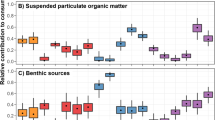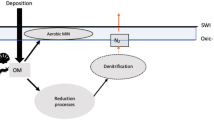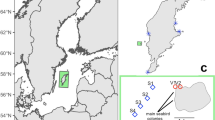Abstract
Most seafloor communities at depths below the photosynthesis zone rely on food that sinks through the water column. However, the nature and strength of this pelagic–benthic coupling and its influence on the structure and diversity of seafloor communities is unclear, especially around Antarctica where ecological data are sparse. Here we show that the strength of pelagic–benthic coupling along the East Antarctic shelf depends on both physical processes and the types of benthic organisms considered. In an approach based on modelling food availability, we combine remotely sensed sea-surface chlorophyll-a, a regional ocean model and diatom abundances from sediment grabs with particle tracking and show that fluctuating seabed currents are crucial in the redistribution of surface productivity at the seafloor. The estimated availability of suspended food near the seafloor correlates strongly with the abundance of benthic suspension feeders, while the deposition of food particles correlates with decreasing suspension feeder richness and more abundant deposit feeders. The modelling framework, which can be modified for other regions, has broad applications in conservation and management, as it enables spatial predictions of key components of seafloor biodiversity over vast regions around Antarctica.
This is a preview of subscription content, access via your institution
Access options
Access Nature and 54 other Nature Portfolio journals
Get Nature+, our best-value online-access subscription
$29.99 / 30 days
cancel any time
Subscribe to this journal
Receive 12 digital issues and online access to articles
$119.00 per year
only $9.92 per issue
Buy this article
- Purchase on Springer Link
- Instant access to full article PDF
Prices may be subject to local taxes which are calculated during checkout





Similar content being viewed by others
References
Watling, L., Guinotte, J., Clark, M. R. & Smith, C. R. A proposed biogeography of the deep ocean floor. Prog. Oceanogr. 111, 91–112 (2013).
Suess, E. Particulate organic carbon flux in the oceans—surface productivity and oxygen utilization. Nature 288, 260–263 1980).
Graf, G. Benthic–pelagic coupling in a deep-sea benthic community. Nature 341, 437–439 (1989).
Dayton, P. K. & Oliver, J. S. Antarctic soft-bottom benthos in oligotrophic and eutrophic environments. Science 197, 55–58 (1977).
Duineveld, G., Lavaleye, M. & Berghuis, E. Particle flux and food supply to a seamount cold-water coral community (Galicia Bank, NW Spain). Mar. Ecol. Prog. Ser. 277, 13–23 (2004).
Ruhl, H. A. et al. Links between deep-sea respiration and community dynamics. Ecology 95, 1651–1662 (2014).
Wei, C. L. et al. Bathymetric zonation of deep-sea macrofauna in relation to export of surface phytoplankton production. Mar. Ecol. Prog. Ser. 399, 1–14 (2010).
Griffiths, H. J., Barnes, D. K. A. & Linse, K. Towards a generalized biogeography of the Southern Ocean benthos. J. Biogeogr. 36, 162–177 (2009).
De Broyer, C. Biogeographic Atlas of the Southern Ocean (Scientific Committee on Antarctic Research, Cambridge, 2014).
Chown, S. L. et al. The changing form of Antarctic biodiversity. Nature 522, 431–438 (2015).
Smith, C. R., Mincks, S. & DeMaster, D. J. A synthesis of bentho–pelagic coupling on the Antarctic shelf: food banks, ecosystem inertia and global climate change. Deep-Sea Res. II 53, 875–894 (2006).
Lins, L., da Silva, M. C., Hauquier, F., Esteves, A. M. & Vanreusel, A. Nematode community composition and feeding shaped by contrasting productivity regimes in the Southern Ocean. Prog. Oceanogr. 134, 356–369 (2015).
Learman, D. R. et al. Biogeochemical and microbial variation across 5500 km of Antarctic surface sediment implicates organic matter as a driver of benthic community structure. Front. Microbiol. 7, 284 (2016).
Barry, J. P., Grebmeier, J. M., Smith, J. & Dunbar, R. B. in Biogeochemistry of the Ross Sea Vol. 78 (eds Ditullio, G. R. & Dunbar, R. B.) 327–353 (American Geophysical Union, Washington, 2003).
Obermüller, B. E., Morley, S. A., Barnes, D. K. & Peck, L. S. Seasonal physiology and ecology of Antarctic marine benthos predators and scavengers. Mar. Ecol. Prog. Ser. 415, 109–126 (2010).
Smith, C. R., Mincks, S. & DeMaster, D. J. The FOODBANCS project: introduction and sinking fluxes of organic carbon, chlorophyll-a and phytodetritus on the western Antarctic Peninsula continental shelf. Deep-Sea Res. II 55, 2404–2414 (2008).
Laws, E. A., Falkowski, P. G., Smith, W. O., Ducklow, H. & McCarthy, J. J. Temperature effects on export production in the open ocean. Glob. Biogeochem. Cycles 14, 1231–1246 (2000).
Lutz, M. J., Caldeira, K., Dunbar, R. B. & Behrenfeld, M. J. Seasonal rhythms of net primary production and particulate organic carbon flux to depth describe the efficiency of biological pump in the global ocean. J. Geophys. Res. Oceans 112, C10011 (2007).
Siegel, D. A. et al. Global assessment of ocean carbon export by combining satellite observations and food-web models. Glob. Biogeochem. Cycles 28, 181–196 (2014).
Jahnke, R. A., Reimers, C. E. & Craven, D. B. Intensification of recycling of organic matter at the sea floor near ocean margins. Nature 348, 50–54 (1990).
Lampitt, R. Evidence for the seasonal deposition of detritus to the deep-sea floor and its subsequent resuspension. Deep-Sea Res. A 32, 885–897 (1985).
MODIS-Aqua Level 3 Global Daily Mapped 4 km Chlorophyll a. Ver. 6. PO.DAAC, CA, USA (Ocean Biology Processing Group, 2003).
Cougnon, E. A., Galton-Fenzi, B. K., Meijers, A. J. S. & Legresy, B. Modeling interannual dense shelf water export in the region of the Mertz Glacier Tongue (1992–2007). J. Geophys. Res. Oceans 118, 5858–5872 (2013).
McCave, I. N. & Swift, S. A. A physical model for the rate of deposition of fine-grained sediments in the deep sea. Geol. Soc. Am. Bull. 87, 541–546 (1976).
Rigual-Hernández, A. S., Trull, T. W., Bray, S. G., Closset, I. & Armand, L. K. Seasonal dynamics in diatom and particulate export fluxes to the deep sea in the Australian sector of the southern Antarctic zone. J. Mar. Syst. 142, 62–74 (2015).
Beans, C. et al. A study of the diatom-dominated microplankton summer assemblages in coastal waters from Terre Adélie to the Mertz Glacier, East Antarctica (139° E–145° E). Polar Biol. 31, 1101–1117 (2008).
Laurenceau-Cornec, E. C., Trull, T. W., Davies, D. M., De La Rocha, C. L. & Blain, S. Phytoplankton morphology controls on marine snow sinking velocity. Mar. Ecol. Prog. Ser. 520, 35–56 (2015).
Arrigo, K. R. & van Dijken, G. L. Phytoplankton dynamics within 37 Antarctic coastal polynya systems. J. Geophys. Res. Oceans 108, 3271 (2003).
Arrigo, K. R., van Dijken, G. L. & Strong, A. L. Environmental controls of marine productivity hot spots around Antarctica. J. Geophys. Res. Oceans 120, 5545–5565 (2015).
Beaman, R. J. & Harris, P. T. Seafloor morphology and acoustic facies of the George V Land shelf. Deep-Sea Res. II 50, 1343–1355 (2003).
Canals, M. et al. Flushing submarine canyons. Nature 444, 354–357 (2006).
Harris, P. T. et al. Continental shelf drift deposit indicates non-steady state Antarctic bottom water production in the Holocene. Mar. Geol. 179, 1–8 (2001).
Caburlotto, A., De Santis, L., Zanolla, C., Camerlenghi, A. & Dix, J. New insights into Quaternary glacial dynamic changes on the George V Land continental margin (East Antarctica). Quat. Sci. Rev. 25, 3029–3049 (2006).
Gutt, J., Griffiths, H. J. & Jones, C. D. Circumpolar overview and spatial heterogeneity of Antarctic macrobenthic communities. Mar. Biodivers. 43, 481–487 (2013).
Barry, J. P. & Dayton, P. K. Current patterns in McMurdo Sound, Antarctica and their relationship to local biotic communities. Polar Biol. 8, 367–376 (1988).
Hosie, G. et al. CEAMARC, the Collaborative East Antarctic Marine Census for the Census of Antarctic Marine Life (IPY # 53): an overview. Polar Sci. 5, 75–87 (2011).
Post, A. L., O’Brien, P. E., Beaman, R. J., Riddle, M. J. & De Santis, L. Physical controls on deep water coral communities on the George V Land slope, East Antarctica. Antarct. Sci. 22, 371–378 (2010).
Roberts, J. M., Wheeler, A. J. & Freiwald, A. Reefs of the deep: the biology and geology of cold-water coral ecosystems. Science 312, 543–547 (2006).
Cummings, V. J., Thrush, S. F., Chiantore, M., Hewitt, J. E. & Cattaneo-ZVietti, R. Macrobenthic communities of the north-western Ross Sea shelf: links to depth, sediment characteristics and latitude. Antarct. Sci. 22, 793–804 (2010).
Beazley, L., Kenchington, E., Yashayaev, I. & Murillo, F. J. Drivers of epibenthic megafaunal composition in the sponge grounds of the Sackville Spur, northwest Atlantic. Deep-Sea Res. I 98, 102–114 (2015).
Goutx, M. et al. Composition and degradation of marine particles with different settling velocities in the northwestern Mediterranean Sea. Limnol. Oceanogr. 52, 1645–1664 (2007).
Lacharité, M. & Metaxas, A. Hard substrate in the deep ocean: how sediment features influence epibenthic megafauna on the eastern Canadian margin. Deep-Sea Res. I 126, 50–61 (2017).
Saenz, B. T. & Arrigo, K. R. Annual primary production in Antarctic sea ice during 2005–2006 from a sea ice state estimate. J. Geophys. Res. Oceans 119, 3645–3678 (2014).
Renaud, P. E., Morata, N., Carroll, M. L., Denisenko, S. G. & Reigstad, M. Pelagic–benthic coupling in the western Barents Sea: processes and time scales. Deep-Sea Res. II 55, 2372–2380 (2008).
Mccoy, F. W. in Marine Geological and Geophysical Atlas of the Circum-Antarctic to 30° S (ed. Hayes, D. E.) 37–46 (American Geophysical Union, Washington, 1991).
Post, A. L. et al. in Biogeographic Atlas of the Southern Ocean (eds De Broyer, C. et al.) 46–64 (Scientific Committee on Antarctic Research, Cambridge, 2014).
Dutkiewicz, A., Muller, R. D., O’Callaghan, S. & Jonasson, H. Census of seafloor sediments in the world’s ocean. Geology 43, 795–798 (2015).
Peck, L. S., Barnes, D. K., Cook, A. J., Fleming, A. H. & Clarke, A. Negative feedback in the cold: ice retreat produces new carbon sinks in Antarctica. Glob. Change Biol. 16, 2614–2623 (2010).
Massom, R. et al. Effects of regional fast-ice and iceberg distributions on the behaviour of the Mertz Glacier polynya, East Antarctica. Ann. Glaciol. 33, 391–398 (2001).
Sambrotto, R. N. et al. Summer plankton production and nutrient consumption patterns in the Mertz Glacier region of East Antarctica. Deep-Sea Res. II 50, 1393–1414 (2003).
Armand, L. K., Crosta, X., Romero, O. & Pichon, J.-J. The biogeography of major diatom taxa in Southern Ocean sediments: 1. Sea ice related species. Palaeogeogr. Palaeoclimatol. Palaeoecol. 223, 93–126 (2005).
Johnson, R., Strutton, P. G., Wright, S. W., McMinn, A. & Meiners, K. M. Three improved satellite chlorophyll algorithms for the Southern Ocean. J. Geophys. Res. Oceans 118, 3694–3703 (2013).
Huang, K., Ducklow, H., Vernet, M., Cassar, N. & Bender, M. L. Export production and its regulating factors in the West Antarctica Peninsula region of the Southern Ocean. Glob. Biogeochem. Cycles 26, GB2005 (2012).
Galton-Fenzi, B. K., Hunter, J. R., Coleman, R., Marsland, S. J. & Warner, R. C. Modeling the basal melting and marine ice accretion of the Amery Ice Shelf. J. Geophys. Res. Oceans 117, C09031 (2012).
Shchepetkin, A. F. & McWilliams, J. C. The regional oceanic modeling system (ROMS): a split-explicit, free-surface, topography-following-coordinate oceanic model. Ocean Model. Online 9, 347–404 (2005).
Timmermann, R. et al. A consistent data set of Antarctic ice sheet topography, cavity geometry, and global bathymetry. Earth Syst. Sci. Data 2, 261–273 (2010).
Beaman, R. J., O’Brien, P. E., Post, A. L. & De Santis, L. A new high-resolution bathymetry model for the Terre Adelie and George V continental margin, East Antarctica. Antarct. Sci. 23, 95–103 (2011).
R Core Team R: A Language and Environment for Statistical Computing (R Foundation for Statistical Computing, Vienna, 2015).
raster: Geographic Data Analysis and Modeling R Package Version 2.3-40 (R Foundation for Statistical Computing, Vienna, 2015).
ncdf4: Interface to Unidata netCDF (Version 4 or Earlier) Format Data Files R Package Version 1.12 (R Foundation for Statistical Computing, Vienna, 2014).
Elseberg, J., Magnenat, S., Siegwart, R. & Nüchter, A. Comparison of nearest-neighbor-search strategies and implementations for efficient shape registration. JOSER 3, 2–12 (2012).
Brown, P. E. Model-based geostatistics the easy way. J. Stat. Softw. 63, 1–24 (2015).
Baddeley, A. & Turner, R. spatstat: an R package for analyzing spatial point patterns. J. Stat. Softw. 12, 1–42 (2005).
Jansen, J. & Sumner, M. D. ptrackr: R-package for tracking individual particles in two- and three-dimensional space. Zenodo https://doi.org/10.5281/zenodo.803493 (2017).
Warner, J. C., Sherwood, C. R., Signell, R. P., Harris, C. K. & Arango, H. G. Development of a three-dimensional, regional, coupled wave, current, and sediment-transport model. Comput. Geosci. 34, 1284–1306 (2008).
Van Ierland, E. & Peperzak, L. Separation of marine seston and density determination of marine diatoms by density gradient centrifugation. J. Plankton Res. 6, 29–44 (1984).
Crosta, X., Crespin, J., Billy, I. & Ther, O. Major factors controlling Holocene δ13Corg changes in a seasonal sea-ice environment, Adélie Land, East Antarctica. Glob. Biogeochem. Cycles 19, GB4029 (2005).
Crosta, X., Debret, M., Denis, D., Courty, M. A. & Ther, O. Holocene long- and short-term climate changes off Adélie Land, East Antarctica. Geochem. Geophys. Geosyst. 8, Q11009 (2007).
Denis, D. et al. Holocene productivity changes off Adélie Land (East Antarctica). Paleoceanography 24, PA3207 (2009).
Rathburn, A. E., Pichon, J. J., Ayress, M. A. & DeDeckker, P. Microfossil and stable-isotope evidence for changes in Late Holocene paleoproductivity and paleoceanographic conditions in the Prydz Bay region of Antarctica. Palaeogeogr. Palaeoclimatol. Palaeoecol. 131, 485–510 (1997).
Tomas, C. R. (ed.) Identifying Marine Phytoplankton (Academic, San Diego, 1997).
Armand, L. K. & Zielinski, U. Diatom species of the genus Rhizosolenia from Southern Ocean sediments: distribution and taxonomic notes. Diatom Res. 16, 259–294 (2001).
Domack, E. & Anderson, J. Marine Geology of the George V Continental Margin: Combined Results of Deep Freeze 79 and the 1911–14 Australasian Expedition (Cambridge Univ. Press, Cambridge, 1983).
Post, A. L., Beaman, R. J., O’Brien, P. E., Eleaume, M. & Riddle, M. J. Community structure and benthic habitats across the George V shelf, East Antarctica: trends through space and time. Deep-Sea Res. II 58, 105–118 (2011).
Venables, W. N. & Ripley, B. D. Modern Applied Statistics with S (Springer, New York, 2002).
Tarr, G., Müller, S. & Welsh, A. mplot: An R package for graphical model stability and variable selection procedures. Preprint at https://arxiv.org/abs/1509.07583 (2015).
Acknowledgements
We thank B. Raymond, S. Wotherspoon and S. Foster for their ideas and support in the analysis of the data, E. Cougnon for her help with the ROMS, and S. Jansen and Jeroen Jansen for their help designing Fig. 1. C. Thun and B. Poignant (Geoscience Australia) prepared samples for the diatom analysis which was funded by a Joint US NSF East Asia and Pacific Summer Institutes and Australian Academy of Science Summer Fellowship at Macquarie University to J.P.W. C. Robineau (supported by Institut Polaire Français Paul Émile Victor (IPEV) and the Antarctic program IPEV 1124 REVOLTA) and J. Delaplanque-Lasserre (supported by Muséum national d’Histoire naturelle (MNHN)) scored the benthic images. We thank the captain, crew and scientific party of the RV Aurora Australis who obtained the samples during the CEAMARC program as part of the IPY #53 Census of Antarctic Marine Life program, with particular thanks to G. Hosie (CEMARC program leader) and M. Riddle (chief scientist on board the RV Aurora Australis). Coastline and glacial features for the figures are taken from the Antarctic Digital Database version 5. J.J. is supported by a Tasmanian Graduate Research Scholarship and a QAS Top-Up scholarship. A.L.P. publishes with the permission of the Chief Executive Officer, Geoscience Australia. This work was completed as part of Australian Antarctic Science project 4124.
Author information
Authors and Affiliations
Contributions
J.J., N.A.H., C.R.J., P.K.D., A.L.P. and B.K.G.-F. conceived and designed the study. J.J., M.D.S. and J.M. developed the software. J.J., N.A.H., C.R.J., P.K.D., J.M., M.P.E., L.K.A. and J.P.W. analysed the data. J.J. prepared all figures and designed the infographic. J.J., N.A.H. and C.R.J. wrote the paper with contributions from all other authors.
Corresponding author
Ethics declarations
Competing interests
The authors declare no competing financial interests.
Additional information
Publisher’s note: Springer Nature remains neutral with regard to jurisdictional claims in published maps and institutional affiliations.
Supplementary information
Supplementary Information
Supplementary Figures 1–9, Supplementary Tables 1–4, Supplementary References.
Rights and permissions
About this article
Cite this article
Jansen, J., Hill, N.A., Dunstan, P.K. et al. Abundance and richness of key Antarctic seafloor fauna correlates with modelled food availability. Nat Ecol Evol 2, 71–80 (2018). https://doi.org/10.1038/s41559-017-0392-3
Received:
Accepted:
Published:
Issue Date:
DOI: https://doi.org/10.1038/s41559-017-0392-3
This article is cited by
-
Natural variability in seawater temperature compromises the metabolic performance of a reef-forming cold-water coral with implications for vulnerability to ongoing global change
Coral Reefs (2022)
-
Intermediate ice scour disturbance is key to maintaining a peak in biodiversity within the shallows of the Western Antarctic Peninsula
Scientific Reports (2021)
-
Exploration of an ice-cliff grounding zone in Antarctica reveals frozen-on meltwater and high productivity
Communications Earth & Environment (2021)
-
Increased sea ice cover alters food web structure in East Antarctica
Scientific Reports (2019)
-
Patterns in the distribution and abundance of sea anemones off Dumont d’Urville Station, Antarctica
Polar Biology (2018)



